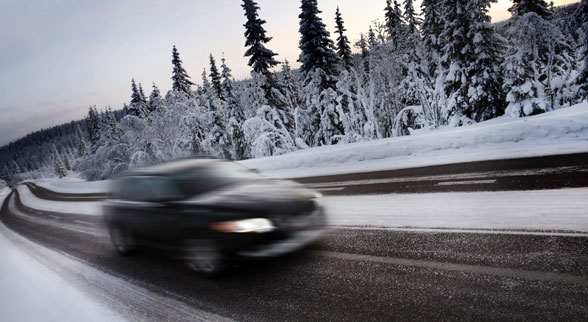It is best to winterize your vehicle before winter strikes. Schedule a maintenance check-up for the vehicle’s tires and tire pressure, battery, belts and hoses, radiator, oil, lights, brakes, exhaust system, heater/defroster, wipers and ignition system. Keep your gas tank sufficiently full – at least half a tank is recommended. Depending upon where you drive, you may consider using winter tires or tire chains.
Driving can be quite a challenge for even the most seasoned drivers when snow and ice are involved. It’s hard enough dealing with congested traffic and inexperienced drivers. AWD very well may save you from getting into an accident. The AWD system recognizes which tires need help and addresses the problem by having other tires compensate for struggling ones. This helps correct the car to the position it should be in.
Driving in the snow and ice is not easy for anybody, let alone for someone with no experience. Just remember to go slow, especially while turning. Give plenty of space to cars around you and gently push your brakes and start early. Allow yourself enough time to get from point A to point B safely, even if it means leaving a little bit earlier. Make sure your vehicle is equipped to handle properly in rough conditions. Oh, and one last tip: Prop open your windshield wipers when you park your car. Your defroster melts all of the snow and ice on your windows, but that water pools on your wiper blades. This freezes and presto, your wipers are now frozen to your windshield! And, if you try to pry them off, you may tear and chip the frozen rubber.
Northern Nevada tends to change its weather fairly quickly. One minute it can start raining and then the next minute the sun starts shining and before you know it snow starts to trickle down! Nevada’s weather is unpredictable but oh so rewarding we get all four seasons in Northern Nevada and it is absolutely beautiful! Plus we are thirty minutes away from the breath taking Lake Tahoe! There are activities every season of the year!
Stay safe and enjoy winter driving!
 Lake Tahoe
Lake Tahoe
Here are some safe-driving tips that will help you when roads are slick with ice or snow:
- Get the feel of the road by starting out slowly and testing your steering control and braking ability. Avoid spinning your tires when you start by gently pressing your gas pedal until the car starts to roll. Start slowing down at least three times sooner than you normally would when turning or stopping.
- Equip your vehicle with chains or snow tires. Chains are by far the most effective, and they should be used where ice and snow remain on the roadway. Remember that snow tires will slide on ice or packed snow so keep your distance.
- Reduce your speed to correspond with conditions. There is no such thing as a “safe” speed range at which you may drive on snow or ice. You must be extremely cautious until you are able to determine how much traction you can expect from your tires.
- When stopping, avoid sudden movements of the steering wheel and pump the brake gently. Avoid locking of brakes on glazed ice as it will cause a loss of steering and control. Every city block and every mile of highway may be different, depending upon sun or shade and the surface of the roadway. (Check your vehicle owner’s manual, if the vehicle has anti-lock brakes, you may apply steady pressure to the brake pedal.)
- Maintain a safe interval between you and the car ahead of you according to the conditions of the pavement. Many needless rear-end crashes occur on icy streets because drivers forget to leave stopping space.
- Keep your windows clear. Don’t start driving until the windows are defrosted and clean – even if you’re only going a short distance.
- Watch for danger or slippery spots ahead. Ice may remain on bridges even though the rest of the road is clear. Snow and ice also stick longer in shaded areas.


























